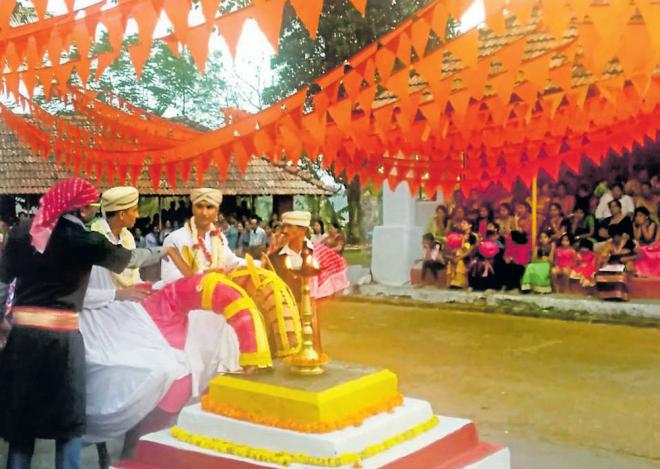
Every year, during the months of April and May, different villages in Kodagu celebrate an interesting festival called Boad namme. Usually these celebrations are associated with the shrines of Bhadrakali.
Residents of Chembebelloor, Bilugunda and other villages roister around their respective temples on different days. The observances, however, begin with a stringent period called pattani. During this period, certain foods and activities are prohibited.
Celebrations
The revelry that follows has boys and men wear various guises and dance around the village.During that night and the following day, these performers masquerade around the town. They are accompanied by musicians who mostly play percussion. Some of the entertainers participate in band kali, while others participate in puli vesha.
Apart from these two, several other enactments are displayed by various entertainers. The Chembebelloor Bhadrakali Temple is west-facing and there is a small Mahadeva shrine inside the temple. One performer carries the moga, a parasol with a mask upon it, of Bhadrakali and performs the theray. A theray, a sacred dance ritual by costumed dancers who emulate spirit deities, is organised at the shrine. During the day of the kudure aata (horse play), teenaged boys wear horse-shaped cane frames around them. One horse performer comes from each of the three hamlets (keri) of Chembebelloor.
According to Coluvanda Jappu, a resident of Chembebelloor, the village comprises three keris: Podakote, Podikeri and Nadikeri. Performers and residents from the three keris gather in the ambala, a public gathering place at the centre of the village. When I had attended the festival last year, there was one performer, in black rags and a tin over his head, who called himself a bear.
Others included people in priestly garbs. Last year’s attraction, however, was a set of men who dressed up as Spartans, in purple chitons and hoplite helmets with red coloured mock horsehair tufts on top.
Folk singers from the Kundera and other families paid a visit. They sang the mane paat, a song in praise of the resident family they visited, while they struck on drums that they carried. Later, we went to the temple yard where we sat and watched with the rest of the villagers. Some villagers with leafy twigs kept in their shirt collars entered the temple at the head of procession, as per tradition. All the actors and musicians entered the shrine after them.
Horse leads the way
Bhadrakali Temple of Bilugunda is in what was the village of Bonda and now between the Bilugunda and Nalvathokkal villages. It is south-facing and has two entrances: one leads to the south and the other to the east. During the Bilugunda Boad namme, the people of Bilugunda enter from the east while the people of Nalvathokkal enter from the south.
In Bonda, dand theray (two theray) and naal theray (four theray) happen in alternative years. During dand theray, as in last year, Bhadrakali and her sister Karikali are impersonated while during naal theray the two daughters of Karikali, one of them being incapable of speech, are also emulated.
The Bonda theray performers dress in white panches around which are tied red skirts that are held up by canes. Upon each of their white turbaned heads they hold up flat wooden framed white umbrellas each of which have flowers and a metal mask of the fanged goddesses. At the back of this parasol hangs a red cloth.
The chief oracle wears a white panche, is independent of the theray, and is called a thiralekara. One horse performer comes from Bilugunda, while another comes from Nalvathokkal. The nine extended families and 18 houses of Bilugunda take turns every year to have a teenaged boy become the horse performer, and a younger boy dresses up as a woman. Traditionally, the horse and the woman performances happened on separate days but now, due to time constraints, they happen on the same day. Last year, Mandepanda Dali, a folk singer, and other folk singers sat within the Madappanda house and sang the dudi paat as some of us listened.
The horse performers wore white turbans, long shirts, trousers and horse frames. They were accompanied by a procession comprising their respective family and village members. A thiralekara walked before each performer while another man carried the traditional oide katti, a war knife, and walked beside him. Two other men carried dudi drums and sticks. A young girl carried a lighted oil lamp on a plate.
A small boy from Bilugunda, who, as an exception, was from the Iynanda family, was dressed in a simple red sari. He carried a mirror and a betel leaf in his hands and walked behind the horse performer. A woman accompanied him in order to help him with the dress if required. Likewise, there was another young boy from Nalvathokkal as well.
Both horse performers came and stood before the shrine in front of the fire altar. Then they raced twice on fallow fields, once in Bilugunda to the east of the temple and the second time in Nalvathokkal to the west of the temple. Once they finished the races they returned to their starting points, by walking rapidly backwards. Meanwhile, the two small boys who dressed as women were made to stand on either side of the temple door. In Bilugunda, there were some performers who dressed up as army men and yakshagana artistes. These are some of the rituals that make this festival unique.
source: http://www.deccanherald.com / Deccan Herald / Home> Supplements> Spectrum / by Mookonda Kushalappa / April 18th, 2017

